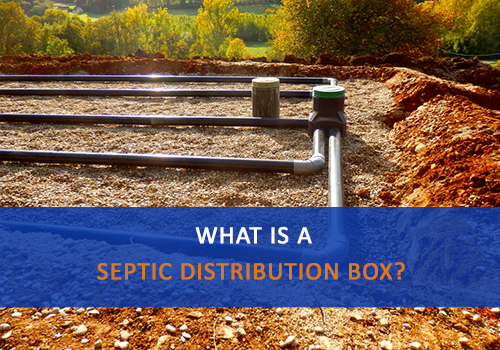If you have a septic system, you most likely know about the system’s basics and how to maintain your system. Most septic owners know to get the septic tank pumped every two to five years that it’s essential to keep a functional, efficient system. However, there are more aspects to the septic system, and one necessary part is the distribution box, sometimes referred to as the d-box.

Parts of the Septic System

Photo Source: epa.gov
A septic system is more than just a septic tank. The septic system works by sending wastewater out of your home through pipes that take it to a tank. From there, the wastewater goes through more pipes to the distribution box. This little hidden box distributes the wastewater evenly through field lines into the leach field (sometimes referred to as the drain field). If the distribution box were not present, all wastewater would pool in one spot, creating unstable ground and making the system unsustainable.
The Septic Distribution Box
The distribution box (or d-box) is usually made of concrete, fiberglass, or plastic. It can differ in size and shape, depending on the septic needs of the household. It is a box with an inlet pipe to send the water from the tank and many outlet holes to disperse the treated water through multiple field lines. These outlet holes can be adjusted depending on the flow of water. It is usually buried shallowly, about one to three feet underground. The durability will depend on many things; the care you give to your septic system, the type of materials used to make the distribution box, and weather. A concrete d-box can last for twenty years if you do not abuse it.
Potential Problems with Your Distribution Box
If you have recently had your septic tank inspected and pumped but are still experiencing plumbing problems, you may want to take a look at your distribution box.
Your distribution box must be level to function properly. If the box is disrupted, it can cause problems for the system. The most likely indication of distribution box issues is either continual plumbing problems even when your tank is functioning or flooding in the leach field.
Weather can also cause problems for the distribution box. Flooding caused by storms or heavy rain can overflow the d-box. Freezing temperatures can cause severe problems for your d-box. Freezing water causes blockages and possibly even cracks in the container, depending on your distribution box’s quality.
Other issues can arise if you drive heavy machinery or vehicles over your leach field/distribution box area. Also, trees or shrubs planted too closely can cause damage if their roots grow down and crack the pipes or box itself. And, if you do not use your septic system correctly, by flushing no-flush items like disposable wipes, cotton balls, feminine hygiene products, grease, etc., this will cause problems throughout the system, not just at the tank and box.
However, knowing the problems that can occur is step one. If you wait until there is a noticeable problem, like an odor or flooding, you will be paying much more in a repair bill than if you maintain your system from the start.
If there is not a good foundation under the distribution box, it is more likely to shift position. Your box should have at least twelve inches of sand or pea gravel underneath it. When installing a new septic system, make sure to discuss this with your septic installation company. If your system is already installed, you can and should have a septic company inspect not just your tank but also the distribution box.
If you are having problems with freezing, your system most likely does not have enough of a slope. The distribution box works using gravity. If the water does not move through the procedure quickly enough, freezing is more of a possibility. During installation or inspection, make sure to discuss this with your septic company.
Simple things you can do as a homeowner will make a big difference—only flush toilet paper. Do not overuse your garbage disposal. Be aware and conscientious of your household water usage. Do not drive over your leach field or plant large plants or trees in that area.
How to Locate your Distribution Box
Your distribution box does not need to be pumped as your septic tank does. But it should be inspected to avoid the high cost of unnecessary repairs.
The distribution box will be down from the septic tank, close to the leach or drain field. You can look for a depression in the ground around this area. You can also look for parallel depression lines in the ground, the field lines, about five feet apart, and follow these back until you reach the box’s location.
If you know your septic site layout, you will have a good idea of where the distribution box is. It will be beneficial if you have a site plan, often given to the homeowner at the installation time. If you never received one or didn’t own the home when the system was installed, you can check at your local health or building department to see if they have a site plan on file.
You can also have your septic company find it for you. They have specialized tools and a better understanding of septic system layouts so that you will be in good hands.
If you have never had your distribution box inspected, give your septic company a call today.

